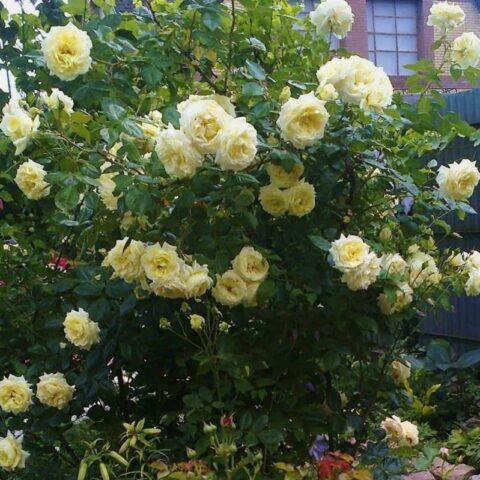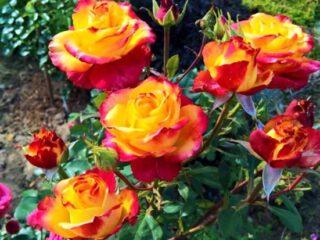Content
The climbing rose Elfe is part of the climber subgroup. Characterized by large flowers and creeping stems. A tall plant with long and abundant flowering is grown in all regions of Russia (except the Far North). Used in ornamental gardening for vertical gardening.
History of selection
The climbing rose was created at the beginning of the 21st century on the basis of the German rose growing company Tantau. The originator of the variety is Hans Jürgen Evers, the founder of the “Nostalgic Roses” series, in which Elf is one of the top three. The climbing rose has repeatedly won prizes at exhibitions.
Description and characteristics of the Elf rose variety
Frost resistance allows the variety to overwinter at a temperature of -25 0C without covering the crown. If the indicator is lower, then the stems freeze slightly. This factor affects the abundance of bud formation. With careful insulation of the crown, the climbing rose overwinters at -30 0C without much damage.
The Elf variety does not tolerate even slight shading. To reveal its decorative qualities, the plant needs sun throughout the day.Only if this condition is met does the climbing rose bloom profusely and retain the flower size stated in the varietal characteristics. In the shade, side shoots stop growing, single buds become small or do not form.
The climbing rose does not tolerate the high humidity of the rainy season. The flowers become saturated with moisture, lose their shape, and droop. The formation of buds stops, the bush stops blooming. Climbing roses also have a negative attitude towards constantly moist soil. It should be placed on well-drained soil with a neutral or slightly acidic composition.
What does the climbing variety Elf look like:
- The climbing rose grows in the form of a tall bush. At the age of two, the length of the stems reaches 1.5 m. The next season, the plant stretches to the size declared by the originator - 2–2.5 m. In the South, there are specimens with branches up to 5 m long.
- Crown width – 1.5–1.8 m.
- The Elf variety is characterized by intensive stem formation. Numerous young shoots grow quickly from the root. From mid-summer, the buds of a second wave of flowering begin to appear on them.
- Perennial vines are brown, woody, thick, with a strong structure, and do not break from the wind. Hard, prickly, wide at the base thorns are located rarely and only on old stems.
- The leaves are glossy, dark green, leathery, with sharp tips. 5 pieces are attached to the petioles. In autumn they do not fall off, without shelter they go under the snow, in early spring their structure and color do not change. They crumble after sap flow, when the climbing Elf begins to gain new green mass.
The plant forms its first buds at the age of two years.The flowering is not too abundant, but is not inferior to bush roses.

Full flowering of the variety begins in the third season.
Description of the climbing rose Elf (pictured):
- The first appearance of buds begins in June on perennial stems and lasts until mid-July. After a week's break, buds form on the shoots of the current year. The cycle lasts until frost.
- Flowers are collected in racemes of 3–5 pieces. They rarely grow alone. At the beginning of the season the buds are larger than at the end. The life cycle of a flower from the moment of blooming is 6–7 days, then it loses its decorative effect and is removed from the bush.
- Climbing Elf belongs to the group of densely double varieties. The flowers are dense, round in shape, 8–10 cm wide. The lower petals of a fully opened bud are curved and form an acute angle.
- The color of the lower part is light green, creamy towards the center, the core is light yellow. Over time, green fragments remain only at the base of the petals, the flower fades and becomes ivory.
Advantages and disadvantages of climbing rose Elfe
The advantages of the variety include:
- long flowering;
- abundant budding;
- early appearance of flowers. The first buds are formed in the second year of the growing season;
- good frost resistance;
- interesting coloring;
- disease resistance;
- standard agricultural technology.
The disadvantage of the variety is considered to be poor shade tolerance and intolerance to high humidity.
Reproduction methods
Elf climber produces seeds that are suitable for propagation. Seedlings are grown from them, and after two years the rose is ready for transplanting. It will bloom only in a few years.The process is effective, but too long, so amateur gardeners do not propagate this variety using seeds.
More often, roses are bred vegetatively. To obtain layering, last year's stem is fixed to the surface in the spring and covered with soil. Do not allow the soil to dry out and cover it for the winter. Climbing rose takes root well with vegetative buds. At the beginning of the season, the plots are planted. In a year they will bloom.
Cuttings are cut from last year's stems when the inflorescences wither on them. The material is placed in a container with soil and left on the site. In the fall they are lowered into the basement, and in the spring they are planted in open ground. This method is suitable for temperate climates.

In the South, the harvested material is immediately planted in the ground and covered with cut plastic bottles
Growing and care
Tall climbing roses are grown only near fixing structures. The support is installed during the season when the seedling is placed on the site. The Elf rose bush can be distributed on a vertical trellis, creating a braided column or pyramid. The climbing variety is ideal for growing on an arch. The rose grows quickly, its stems are periodically fixed in any given direction.
The climbing variety Elf forms a dense bush, so a wide area is allocated for it. There should be good air circulation in the central part of the crown. Climbing rose develops well on loamy soil, does not tolerate stagnant water, and does not like drafts.
Care instructions:
- It is necessary to constantly maintain soil aeration and prevent compaction of the top layer. During loosening, weeds should be removed.
- The rose is mulched with compost mixed with peat.This prevents the soil from drying out quickly and stops the growth of grass.
- Cut off the flowers after they wither.
- The frequency of watering depends on precipitation. During the dry season, roses need about 30 liters of water per week.
The main condition for full growth is feeding. Climbing roses respond well to the addition of humus, compost, and mullein. Additionally, in the spring they are fertilized with nitrogen. During flowering, potassium and phosphorus are used. In the fall, choose a complex composition that does not include nitrogen.
The Elf variety is prepared for wintering only in regions with cold climates. In the subtropics, the climbing rose does not need any preparatory measures:
- The plant is mulched with compost and straw or dry leaves are sprinkled on top.
- Remove the rose from the structure, cut off the lashes older than three years.
- The crown is laid on a straw or leaf litter and covered with spunbond. You can install low arcs over the bush and stretch the burlap.
Pests and diseases of climbing rose Elf
The Elf variety has quite strong immunity to infection. The climbing rose requires a location in the sun, so fungal infection does not threaten it. During the cold and wet season, black spot may occur. If you treat the plant with Fitosporin in the spring, the problem will be avoided.
Among the pests that parasitize roses are leaf rollers and bronze beetles. The drug “Iskra” is effective for eliminating insects.
In spring, the climbing rose Elf requires preventive treatment with colloidal sulfur.
Application in landscape design
A variety with glossy leaves, a dense crown and abundant flowering is suitable for any corner of the garden or plot. Growing is possible only with a fixing support, so climbing roses are used for vertical gardening.
Some of the most common design solutions:
- Summer verandas are decorated.
- Decorate flower beds.
- Used for zoning a site.
- Cover unsightly areas.
- Seating areas are being set up.
- Grown on arches
The climbing variety Elf in mass planting harmonizes well with red and pink flowers.
Conclusion
Climbing rose Elf is a tall German variety created for vertical gardening. The plant is characterized by good frost resistance and low maintenance requirements. Grows in any climate, but only in sunny areas. Does not tolerate high humidity and shade. In the video you can see the climbing rose variety Elf.
Reviews of climbing rose Elf















